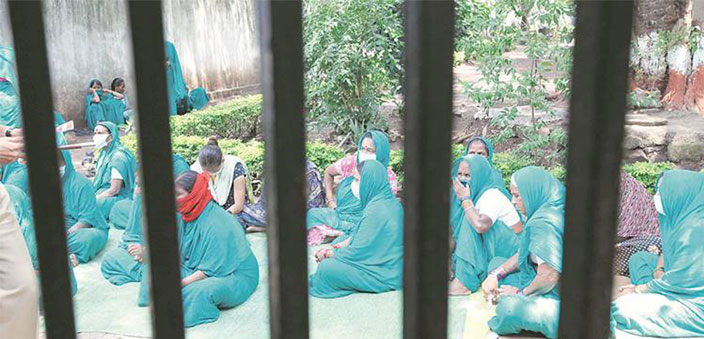In India prisons came into focus in the early 1980s, when as part of the National Police Commission,
K.F. Rustomji highlighted prison conditions and the plight of undertrial prisoners. Activists like Sheela Barse filed public interest litigation petitions on custodial conditions, and judges like Justice P.N. Bhagwati and Justice V.R. Krishna Iyer passed landmark judgments. These steps brought much needed relief to thousands of undertrials, who were released on personal bond or simply discharged. However, the situation on the ground seems to get worse by the day.
A recent report by the National Crime Records Bureau (NCRB) on the state of prisons in India underlines the dysfunctional state of the country’s jails. Year after year, dry statistical tables, which barely make it to the media, paint a grim picture of official neglect and personal tragedy in our 1401 prisons.
The NCRB’s most recent figures found India’s 1401 jails held 419,623 prisoners when the countrywide capacity was 366,781. The Commonwealth Human Rights Initiative (CHRI)’s analysis of state-by-state numbers is even more alarming; some state prisons house twice as many prisoners as they can hold, and a number with 500 percent occupancy. A look at the following statistics underlines the challenge:
• Seven in 10 prisoners in the country were either illiterate or educated only upto high school.
• Nearly 70% of the Indian prison population had not yet been proved guilty.
• Across the nation, there was just one guard for every ten prisoners.
• One medical staff for every 225 prisoners, and
• One correctional staff for every 702 prisoners.
Further, a prisoner dies every five and a half hours which highlights the neglect, violence and personal tragedy behind prison walls.
Women prisoners on the rise
According to the September 2015 report by the World Prison Brief and Institute of Criminal Policy Research, since the year 2000, the population levels of women prisoners have grown much faster than male prison population levels. The numbers of women and girls in prison have increased by 50 percent in the past 15 years. India too has seen an increase in population of women prisoners. With a population of 11094, women inmates formed 3.5 percent of prison population in 2001. Fifteen years later, Indian prisons house 17834 women inmates, an increase of 61 percent. Therefore their share in prison population has gone up to 4.3 percent. In the last decade, 477 women inmates have died inside prison. Fifty-one women inmates were reported dead in prison in 2015.
Women going through the criminal justice system are called the “forgotten offenders”. They are said to be forgotten because they are a minority in the system. The prison structures and services that have developed are based on the characteristics of male criminal population. The problems and concerns of women, have never influenced the nature and range of facilities and programmes, subjecting women prisoners to more onerous conditions. Additionally, based on the image of “fallen women” they have been considered less redeemable and less worth retrieving. As they are less dangerous or disruptive, and easier to deal with, they are easily neglected. In the name of ‘paternal protection’, women are subjected to greater security than they require for public safety. Hence the opportunities offered to them are substantially inferior to those provided for their male counterparts in all areas: education, recreation, occupational programmes, social and cultural programmes, employment opportunities, and even medicare.
India’s women prisoner population has ballooned 61% over the past 15 years, far outstripping the male growth rate of 33%, but infrastructure growth hasn’t kept pace. Women are mostly confined to small wards inside male prisons, their needs are always considered secondary to those of the general inmate population. They remain low on policy priority, and hence the coverage of facilities such as sanitary napkins, pre and post-natal care for pregnant mothers is patchy.
Deplorable condition of prisons
In most Indian jails, for example, pieces of cloth are used in place of sanitary pads. There is shortage of women wardens, superintendents, assistant superintendents, doctors, and counsellors. As a result, there are huge gaps between the needs of women inmates and the administration providing them. There’s also a large gap in the range, level, and quality of vocational training given to women inmates as compared to men. The diet of women inmates is rationed and the ratio they get is smaller as compared to their male counterparts.
Medical care is the other aspect which must be underscored. As medical staff is limited, women prisoners continue to be examined and treated by male doctors, though the Prison Model Jail Manual enjoins that every woman offender shall be examined by a Lady Medical Officer once a month, besides on initial admission and readmission after bail, leave, or emergency release. Very limited attention is available for pregnant prisoners in prenatal and post-natal care, and access to outside specialists, particularly gynaecologists and obstetricians. Those who want abortion, under the Medical Termination of Pregnancy Act of 1971, are unable to obtain it easily.
Women tend to feel the impact of being imprisoned that much more acutely than men do. This is, in part, because of the greater stigma attached to women in prisons and, in part, because of the lack of social support and the psychological stress of being separated from family and children. Prisons can cause major damage and disruption to the lives of vulnerable women and their families. Most of them are in prison for non-violent offences and pose no risk to the public. Therefore, consideration should be given to the development and implementation of non-custodial strategies for women, particularly during pregnancy, or when they have young children.
Prisoners too have a right to life
Women face lot of difficulties in prisons − from bad infrastructure to overcrowding. Further, all kinds of convicts are kept together. Women, in tribal areas, face even greater discrimination. They are usually implicated on false charges. At times, police take women family members into custody when male culprits are missing. Families of women prisoners have to travel a long distance as they are kept in far away cells; in some jails like in Chattisgarh, men and women are kept together, but there are no separate prisons for women. There is only one open-air prison for women in the country in Pune.
The model jail manual released last year makes it clear that the state is under an obligation to protect the residuary rights of prisoners after they surrender their liberty to a legal process. One can only reiterate a principle already enshrined in it; the management of prisons must be marked by firm discipline, but with due regard to the human rights of prisoners. Prison reforms are not only about amenities and conditions; they must also address the prisoner’s right to life. The prison manual also calls for women doctors, superintendents, separate kitchens for women inmates, and pre- and post-natal care for pregnant inmates, as also temporary release for an impending delivery. None of these guidelines is consistently implemented across district and state jails.
When the state deprives inmates of their liberty, it takes on a sovereign duty to provide for their health care without any discrimination based on their legal status. It is time to entrench health policy of inmates as an integrated component of the national health policy and ensure that they receive the support, care and treatment they are entitled to.
Prison health-care services ought not be stymied with budget constraints, and poor staffing and medical facilities. Qualified health professionals – independent of the prison administration – are essential to provide services to inmates. Reviewing our criminal justice system would invariably have to include a transformation of our approach from its current punitive form to a rehabilitative and reformative one, which would facilitate social reintegration of inmates. In the words of Madiba (Nelson Mandela), “A nation should not be judged by how it treats its highest citizens, but its lowest ones”.


 [/column]
[/column]